Noteworthy Notebooks (Part 2): The Big Names in Erasable Notebooks
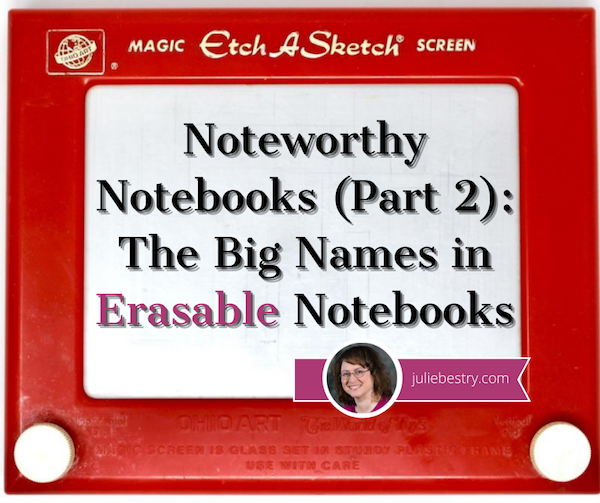
CHILD’S PLAY
Do you remember the Etch A Sketch? Invented 61 years ago, the iconic red tablet (long before iPads) was shaped to look a bit like a flat-screen TV (long before flat-screen TVs), but required no electricity, batteries, or WiFi (which is good, because the internet hadn’t been invented yet, either). By turning the horizontal and vertical knobs (designed to look like old-time TV knobs) you could create words. (Sorta.) You could make art!
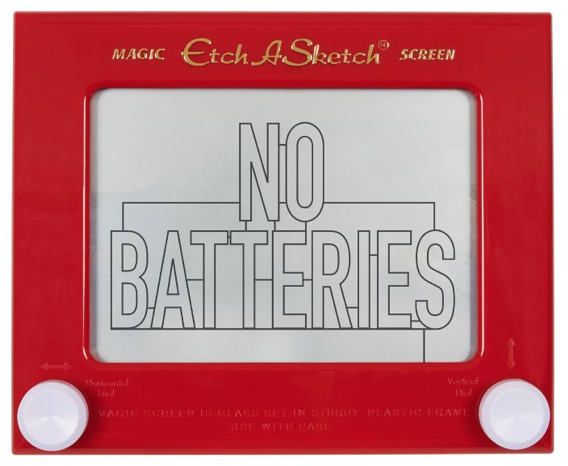
Granted, most of it didn’t look particularly artistic, but you got to be creative, and when you were done and ready to create a new masterpiece, you just shook the entire Etch A Sketch and the whole screen was erased, and you could start fresh. (If only life worked that way!)
There was another toy, less iconic, but no less common. You may not know the name Magic Slate, but I bet you had one. As it dates back to the 1920s, I bet your grandparents even had one! On top of a stiff cardboard backing, there was a black slate, and atop that, a sheet of plastic. Using a stylus, you could draw or write; to erase, just lift up the sheet of plastic, and your Magic Slate was ready for you to start anew.
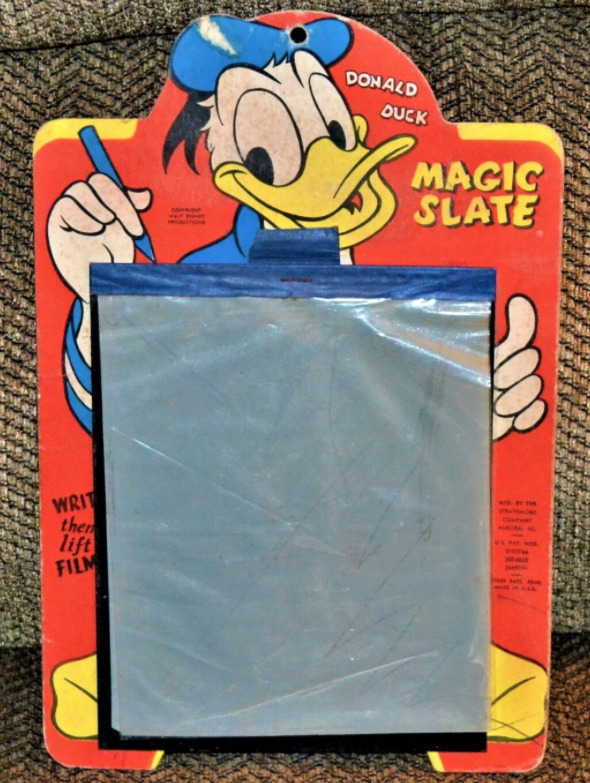
A few years ago, some savvy designers realized that while we like all of the features of computers, tablets, cell phones, and the internet, we also really like to write and draw by hand. And while the newest tablets offer some of those features, writing and drawing on glass just doesn’t feel the same as drawing on paper.
So, one after another, a series of designers came up with notebooks that are somewhat (more or less, depending on the product) like writing or drawing on paper, but you can erase what you’ve created.
No, you don’t have to write in pencil (and fill your desk with erasure crumbles). And yes, you can retain your content and still use your notebooks over and over. And you can be gentle to the environment by not requiring whole forests to be cut down. The natural grandchild of the Etch A Sketch and Magic Screen are erasable notebooks.
ROCKETBOOK
If the Etch A Sketch represented the early and mid-20th century, Rocketbook‘s wide variety of fancy-schmancy, modern, erasable, reusable notebooks are the future. (In fact, when Rocketbook went on the TV show Shark Tank, they described their products as they do in all their videos, explaining that they make “notebooks for the future” with sustainability in mind.)
The initial Rocketbook was the Wave, a crowdfunded spiral-bound notebook that appeared on the scene in 2015. You could write on the pages with any of the colorful Pilot FriXion erasable pens, and fill every page, edge-to-edge and top-to-bottom.
Once your notebook was full, instead of buying a new one, as you’d do with paper notebooks, you could capture the contents of the Wave by scanning it with the special Rocketbook app. Tiny icons at the bottom of each page directed the app to send your creations to the cloud, and specifically to the right service in the cloud, like Dropbox, Google Drive, Evernote, OneNote, or even to email. Done scanning? You’d just erase the contents by putting the Wave in the microwave.
Yes, in the microwave. (Hence the Rocketbook Wave.) When the logo on the cover turned from blue to white, you knew the notebook was erased.
Weird. I mean, everyone thought that was weird. I had a small microwave oven, and the first time I saw the notebook, I realized that while the Wave would fit inside my microwave, the design would make it hard to get INTO my microwave without rolling or folding it. Plus, I had some serious hygiene concerns with putting something one carted around all day into the same device where I cooked my food. (OK, where I boiled water and made popcorn, but still…)
Also, each of the notebook’s 80 pages could be erased only five times. FIVE times? I tried to recall how many pages of transcription-like notes I took in college classes, how many pages of notes I take during a client session, and how many I write in almost any educational setting. At that rate, I’d be buying new Waves every month or two. That might be sustainable for the rainforests, but not for me!
Bit by bit, people embraced Rocketbook’s Wave, and I enjoyed seeing it up-close at NAPO conferences when my colleagues would take notes, but my love for the environment and for gadgets was not as profound as my love for keeping food and non-food things in separate realms, and my dismay over the limited number of uses.
(I also wish I’d asked where they were finding microwave ovens at the conference hotel; I take almost a full legal pad of notes during a three-day conference. Were they uploading, erasing, and starting over every day? Inquiring minds…)
Rocketbook, however, wasn’t worried about naysayers like Paper Doll, and continued to expand the product line and make some of the most goofily entertaining office supply promotional videos on the market. As they went along, everything they invented with their accent on creating notebooks “for the future” focused on four key attributes of their products: write, scan, share, reuse:

Next came Rocketbook Everlast, which was later renamed Core, as it serves as the core of the Rocketbook lineup. The pages of the spiral notebook were created from a polyester composite rather than wood, but still felt like paper, and while marks made with the Pilot FriXion erasable pens would stay smudge-free, entire pages could be erased with the wipe of a damp cloth. The Core is “infinitely” erasable, they say, and while I’m not sure anyone can test that claim, infinity is definitely a higher number than five.
As with the original Wave, the Rocketbook app lets you scan the page using the QR code at the bottom, and whichever of the tiny icons you select will direct the app to send your work to be stored at the right cloud storage site. iCloud, Slack, and Box were added to the original options.
Note: the icons on the bottom page are generic: Rocketbook’s logo, diamond, apple, bell, shamrock, star and horseshoe. You configure each icon to link to whichever service you prefer, so as Rocketbook’s integrations grow, so do your options.
Another cool features: if you hand-write hashtags (# marks) around the title of your page at the top, it will transcribe your handwritten note as text to create as the title of the document.
The Rocketbook universe (see what I did there?) continues to expand. Among the erasable notebooks, there are:
- Wave, the original Rocketbook, comes in two sizes, Standard (8.5″ x 9.5″) and Executive Size: (6″ x 8.9″), each with 80 dot-grid pages on acid-free, fine-grain paper, with a blue cover. The left-side spiral binding is polypropylene. Each page can be erased five times by microwaving. $27 for the Standard, $25 for the Executive, directly from Rocketbook, or $21 for the Standard and $27 for the Executive at Amazon.
- Core (formerly Everlast), comes in two sizes, Letter (8.5″ x 11″ with 32 pages) and Executive (6″ x 8.9″ with 36 pages) in either dot-grid or lined formats. The covers come in eight colors: Infinity Black, Atomic Red, Midnight Blue, Neptune Teal, Beacons Orange, Deep Space Grey, Terrestrial Green, and Scarlet Sky, and the left-side spiral binding is polypropylene. A microfiber cloth is included, and all pages can be erased by wiping with a damp cloth. The Letter size is $34 and the Executive is $32 at Rocketbook, or for $28 and $24, respectively, on Amazon.
- Fusion looks like the Core from the outside, coming in the Letter and Executive sizes, with the same eight cover color options and connects to the same cloud services. But Fusion takes the Rocketbook a step beyond with formatting . The 42-page Fusion uses seven different page templates: task list, weekly planner, monthly calendar, idea list, plain, lined and dot-grid pages, and an ORK goal template (with space for objectives, key results, an action plan, and reflections). The Letter size is $37 and the Executive is $35 at Rocketbook with similar pricing at Amazon.
- Panda Planner is a Rocketbook extension of the popular Panda Planner line of happiness-inspiring personal planners. The exterior features are similar to the Core (though it’s only available in Infinity Black, Neptune Teal, Midnight Blue, and Scarlet Sky), and it comes in Letter (32 pages) and Executive (36 pages) sizes. Instead of the Rocketbook logo, the Rocketbook Panda Planners bear the panda head logo. Pages include undated monthly, weekly, and daily templates to organize your tasks and appointments, and goal and motivation templates for “building happiness.” Like the Fusion, the Rocketbook Panda Planner is priced at $37 for the Letter size and $35 for the Executive, at both Rocketbook and Amazon.
- Matrix comes in only one format, the 32-page Letter size (8.5″ x 11″) with cover colors including Infinity Black, Midnight Blue, Neptune Teal, Deep Space Grey, Terrestrial Green, and Scarlet Sky. Instead of dot-grid or lined, the Matrix uses a graph pattern specifically designed for STEM classes and technical note-taking. In addition to 30 graph pattern pages, the Matrix includes a scientific index page to track and improve organization, imperial and metric rulers for field measurements, and a place to label the 1/4” square units. The Matrix runs $24 at Rocketbook and on Amazon. (There’s no word as to whether Neo and Morpheus will help you with your STEM homework in the Matrix. I suspect that will cost extra.)
All of the versions of the Rocketbook referenced so far have the spiral binding on the left side. Although Rocketbook has not (yet) created any landscape formatted notebooks, they offer two options with the spiral binding at the top:
- Rocketbook Flip is billed as “the galaxy’s first ambidextrous notebook,” and it’s definitely a boon to lefties with the spiral running along the top. The covers come in Infinity Black, Midnight Blue, Neptune Teal, Deep Space Grey, Terrestrial Green, and Scarlet Sky, and the pages themselves do double-duty, as each page is formatted with lines on the front and a dot-grid on the back. (A version with blank pages is also available.) Like the Core, it comes in Letter (8.5″ x 11″ with 32 pages) and Executive (6″ x 8.9″ with 36 pages) and runs $34 for Letter and $32 for Executive at Rocketbook and $30 and $27, respectively, on Amazon.
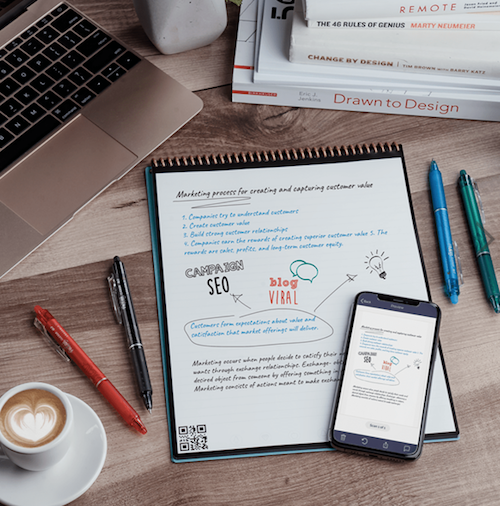
- Rocketbook Mini takes the Flip and shrinks it down to 3.5″ x 5.5″ to fit easily in a purse or pocket. As with the Flip, the spiral binding runs across the top, and the cover comes in Infinity Black, Midnight Blue, Neptune Teal, Deep Space Grey, Terrestrial Green, and Scarlet Sky. The Mini is 48 dot-grid pages, and costs $16 at Rocketbook and a little less on Amazon.
All versions of the Rockebook come up a Pilot FriXion erasable pen, and all versions except the Wave come with a grey microfiber cloth.
And now, there’s a new product on the horizon, the Axis, which has just completed its Kickstarter campaign. Because the Axis has some special features beyond reusability, we’ll be returning to it in a few weeks when we cover customizable notebooks.
While Rocketbook is the biggest name in erasable notebooks, it’s definitely not alone.
WIPEBOOK
Wipebook imagines its products as a blending of traditional notebooks with whiteboards, but instead of using erasable pens, Wipebook’s works with either correctable markers or dry-erase markers. But we’ll get to that in a moment.
Instead of focusing on notetaking, we’re supposed to consider Wipebook notebooks as the ultimate reusable whiteboard notebook for brainstorming on-the-go. You can write or draw, make temporary notes and squiggles, and then erase without wasting paper. In fact, they have a nice little motto: “Go ahead and make a mistake. Nothing should be permanent.” To that end, they’ve upgraded their pages to a new hypergloss film designed to make erasing and reusing an even smoother process.
Every Wipebook contains 32 graph, ruled or blank 8 1/2″ x 11″ pages. The ruled notebook has a green cover; the graph version’s cover is blue, and the one with blank pages is red. There’s nothing fancy to look at, but the focus is on the use.
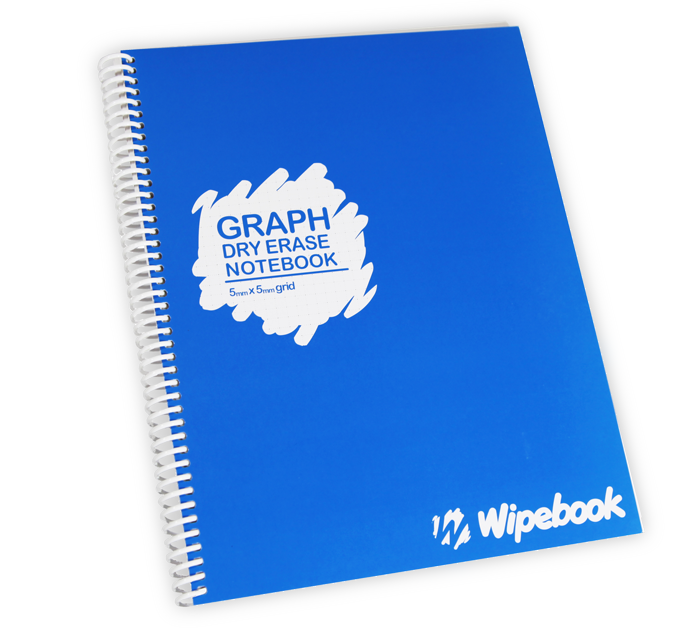
Depending on the longevity you need for your doodles and masterpieces, Wipebook recommends two options. First, they like Staedtler Lumocolor correctable markers as they won’t smudge on the hypergloss pages, but the ink can be removed with the integrated erasers (for a small area) or a dry cloth, either when you’re finished, or to correct mistakes. They come in two styles, fine and medium tip, and unlike traditional dry-erase markers (which you can also use), they provide a more semi-permanent solution.

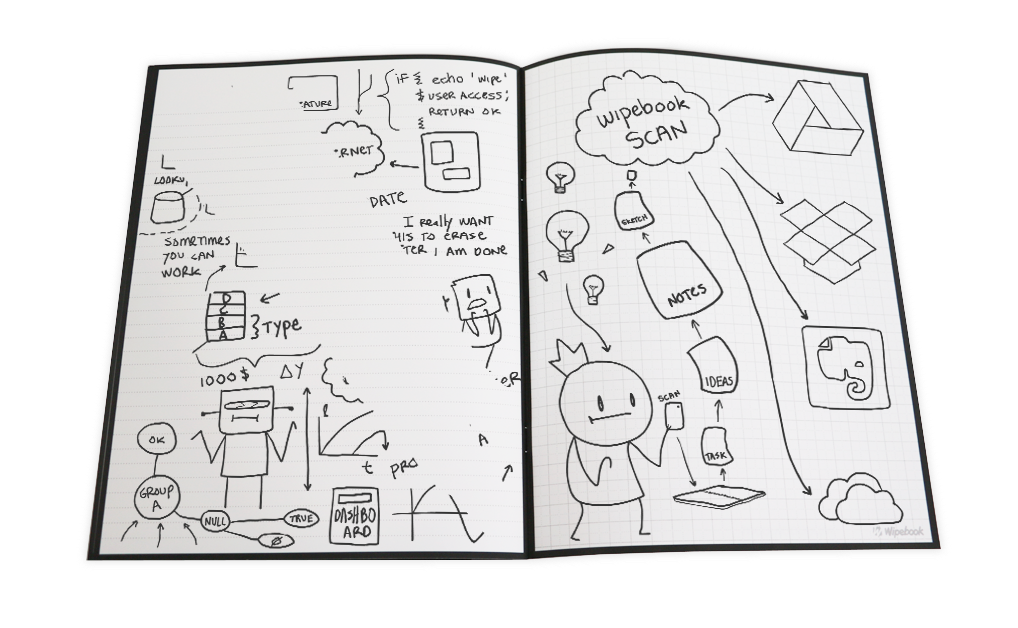




While I am not a participant in this category, it is interesting to see what is being developed. As always, I love your writing style Julie (“definitely more than five” had me laughing!).
I can see the environmental appeal of reusability, and imagine products like these will continue to evolve in one form or another. Maybe someday I will have a “pen” inserted into my index finger that you will write and record to a central location from any surface.
But even if this happens, I’ll probably still have my paper nearby. I just love paper. Sigh.
I’m with you, Seana. I love my purple legal pads. With a bound notebook, I often feel an obligation to make things perfect — good handwriting, great ideas. The legal pad makes it easy for me to “cheat and delete” by tearing off a page; the lack of permanence prevents me from obsessing. Y’know, maybe that’s an aspect of an erasable notebook I can address in the follow-up post. Look at you, inspiring me!
Interesting timing! Just a few weeks ago I freecycled a Rocketbook Wave that a client got as a promotional item at some event and never used. I had to research what in the world it was, and it seemed really weird to me. (I’m glad I’m not alone in that regard.) But someone in my freecycle community was thrilled to get it!
I kept reading about Rocketbook, but didn’t see one in action until the NAPO conference in 2019. It’s intriguing, but I’m glad they advanced beyond the Wave. I bet the Freecycler is enjoying it, provide whoever got it has a big enough microwave!
OK, I’m feeing chagrined that I am supposed to be fairly tech-y and yet somehow I’ve never heard of Rocketbook. :-0 Thank heavens for you, Julie, keeping me up to date on things! I do use my iPad and Apple pencil a fair amount, but it definitely doesn’t feel like paper. I’m inspired to try out one of these options now, and I appreciate your thorough detail (good that a lot of these upload easily to Evernote). Perhaps you’ll see me at NAPO2022 sporting a Core!
OMG, Sara, I’m delighted to hear you say that, because I worried people might think it was old hat, kind of like when I write about Evernote and imagine people are thinking, “What? This again?” but it’s new to them.
But don’t buy anything until you read NEXT WEEK’S continuation on the lesser-known, but also intriguing options.
Super round up of the alternatives available to the pencil and paper you’ll pry out of my cold, dead hands, Julie. I’m going to be sharing this wealth of information with all sorts of more flexible people, but for me there’s something about the feel of the pencil, the sound of the pencil, the way I can keeps scraps of paper all over my desk and then toss them when I’m done with them that can’t be beat.
LOL, Lucy, and those are just the big names in the game. Next week, you get to see the more unusual and curious ones! I have meaning to do another deep dive into notebooks for more than a decade, so you can tell I’m having fun with this. I’ve even got some real pencil options for you over the coming weeks!
This is great information. I have been thinking about purchasing a Rocketbook, so I appreciate the breakdown of offerings. I think this would as make a great gift for my tech-loving and note-loving friends. I can’t wait to learn more next week.
Yay! I think that by the end of this whole series, everyone will be able to find a notebook perfect for each individual soul. I’m waiting for the notebook that will make me lunch!
You’re making me think. (You always make me think.) It seems I take fewer and fewer notes as I get older. But I AM interested in what’s out there these days, so thanks for doing all the leg work! I had no idea there were so many erasable versions (and I see there are more to come in your series). I should say that in SOME ways (like in a class) I take fewer notes. But (even though I also use the Notes feature on my iPhone) I ALWAYS need a paper notepad handy when I’m talking on the phone or Zooming or watching TV. And I AM, starting this year, using erasable sticky notes for my daily to-dos. So, who knows? Maybe I’ll find something for me in your series after all.
Aha, erasable sticky notes! Well, there’s a blog post waiting to happen! (Seriously, I’ve got a whole series on sticky notes and index cards circling my brain.) I think the internet effect has made it harder to uni-focus, so I find that unless I take notes (in meetings, on Zoom, in a class), I’m likely to let my mind wander, so I’m actually notetaking more, rather than less. And I never use the notes feature on my phone…I’ll probably never be able to type on a phone for more than a few words; if I can’t dictate, it’s not going to happen!
Thanks for reading, and there are MANY novel notebook types still to come!